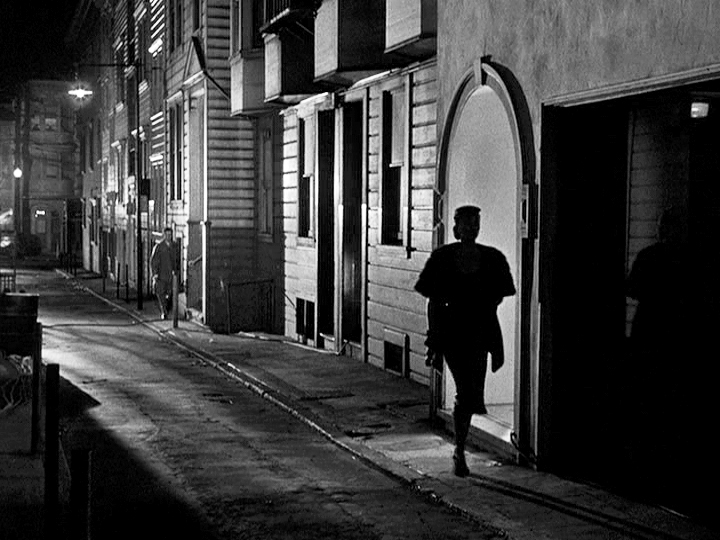
Edward Dmytryk was a talented filmmaker whose career and life were severely damaged during Hollywood’s red scare. As one of the Hollywood Ten, he refused to testify to the House of Un-American Activities Committee and was sentenced to jail. He fled to England, where he made some high quality films including another of my recommendations, Obsession. When the Brits kicked him out he came back to the U.S. and was incarcerated. He then decided to testify against his communist associates, meaning that Hollywood was divided between those who hated him as a communist and those who hated him for naming names. However, in 1952 his career got back on track when Stanley Kramer hired him to direct The Sniper, a brooding B-picture about a serial killer that gave Dmytryk a chance to express his alienation and isolation on screen.
The story opens with psychologically disturbed veteran Eddie Miller (Arthur Franz) struggling against his impulse to gun down a woman in his neighborhood, right at the moment she is kissing her lover on the stoop. As Miller walks the streets, his chance encounters illuminate how he has felt scarred by women from childhood through his adult life, filling him with a mixture of misogyny and sexual frustration. After his efforts to seek help for his psychiatric problems are met with incompetence and indifference by the health care system, this ticking time bomb of a man is stung when a women to whom he is attracted (Marie Windsor) does not reciprocate his feelings. In a rage, he comes unraveled and goes on a fearsome, guilt-wracked hunt for the women whom he believes have wronged him.
For the period in which it was made, The Sniper was startling stuff, particularly the scenes of Miller stalking and then executing his victims. In style and structure, the film draws a good deal from the the police procedurals that became popular after the war (see my recommendations He Walked by Night and The Naked City) as well as from film noir. It also has a pronounced streak of urban alienation and rage that prefigures later films like Taxi Driver (I was not surprised to learn that Martin Scorcese admires The Sniper).
Other than Adolphe Menjou, who plays the police detective who tries to track Miller down, the cast of this low-budget picture are unknowns with unremarkable faces, which works well with the underlying message that horrors such as the film portrays have become everyday, ordinary events. Harry Brown’s script, which is based on a story by Edna and Edward Anhalt, underscores this point even more by having the city in which the crimes occur have no name. It could, implictly, be anywhere.
Most of the film was shot in San Francisco, which has rarely looked as moody or lonely. When Miller stalks his first victim, the shadows are surreal as is the lack of any other person on the street. Burnett Guffey, a number of whose films I have recommended here, contributes effective photography and Dmytryk worked with him to create excellent camera set ups throughout. I particularly liked the scene where Miller, who has a menial job delivering dry cleaning, is being upbraided by his boss (another women who makes him feel weak and worthless). Rather than shooting the scene in an open space, the film makers put the camera in the front of Eddie’s parked van looking back at him as he crouches in the cramped, dark space surrounded by hanging dresses. His boss on the loading deck is visible because the van’s back door is open, making her tower over him as if he were a worm under her heel.

The only significant weakness of the film is something characteristic of many Stanley Kramer productions (Judgement at Nuremberg, The Wild One, Guess Who’s Coming to Dinner): It needlessly makes some of its points with a sledgehammer. Starting a film with a printed message telling the audience how shocking and serious the subject is and including a scene where some authority-figure gives a pious speech about how society-is-to-blame are the sort of things that earned Kramer a reputation as the kind of sanctimonious and self-satisfied liberal who drives away more people from his causes than he draws in. Some of that cringeworthy stuff is on display here, and it just doesn’t work.
But let that flaw go and this tautly directed, disturbing film will get under your skin. My belief is that The Sniper is in the public domain, so I offer this link as a place where you can watch it for free.
p.s. Trivia: The bar where Eddie’s first victim sings is the Paper Doll Club, famous in real life as one of America’s first lesbian bars even though it isn’t portrayed that way in the movie.
